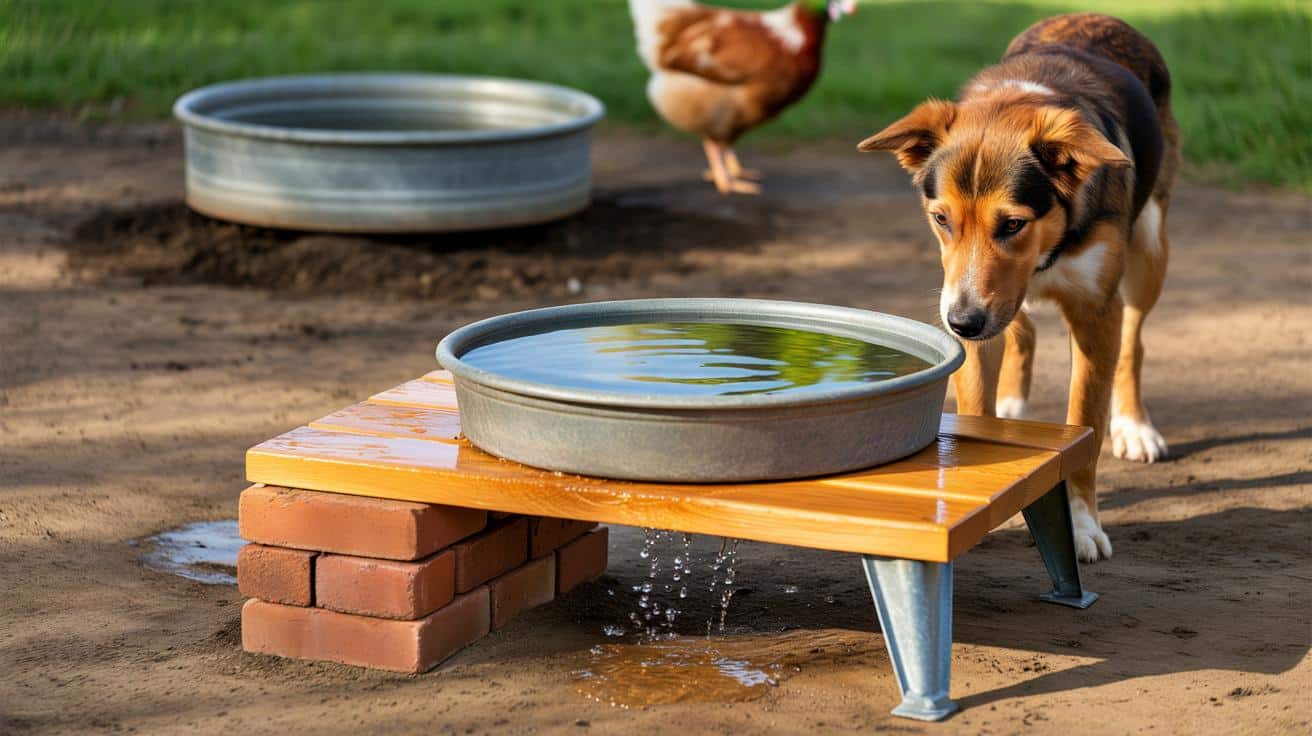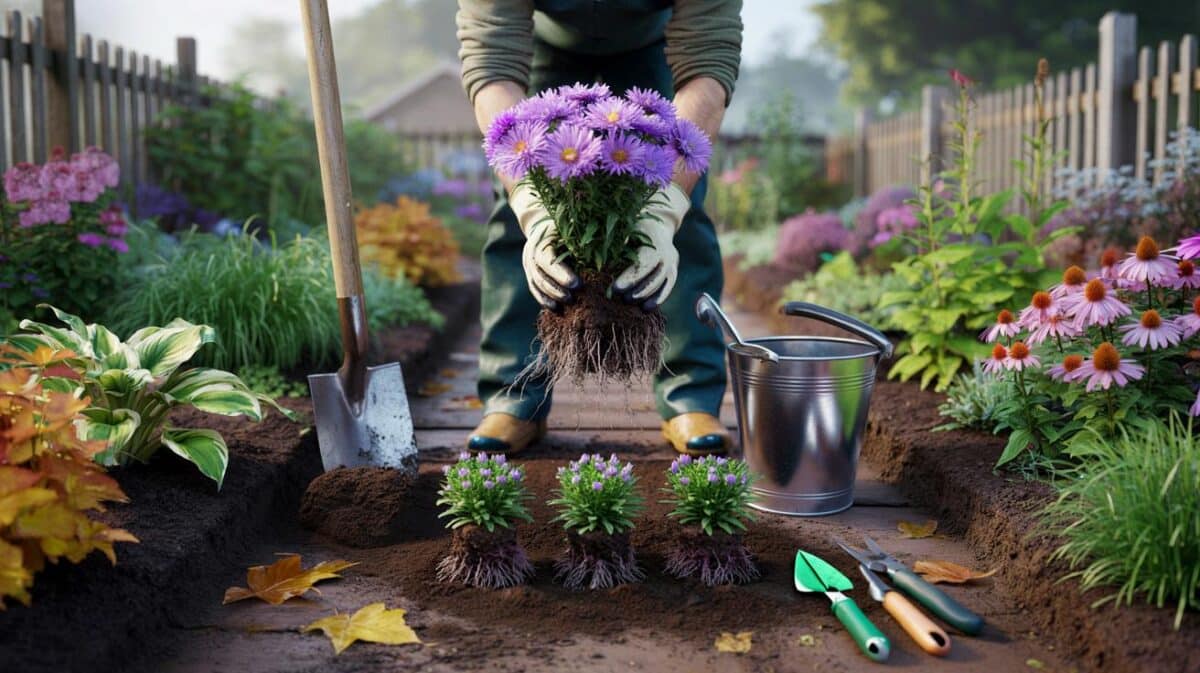Pet owners and smallholders face the same headache: bowls and troughs fill with mud, feed and algae within hours. A revived, no-frills stand built from bricks and a timber board raises the container, limits contamination and shortens cleaning time. Early adopters across the country say it cuts grime sharply while using common tools and low-cost parts.
What sits behind the revival
Farm families in the nineteenth century learned a simple rule. Water stays cleaner when you keep it off the ground and out of splash zones. Livestock and pets kick soil, shed hair and splash feed into bowls placed low. A modest lift changes the geometry of mess. Traditional setups used oak or chestnut boards on bricks, often with a slight forward lean to drain away residue. Variants appeared by region: terracotta in warmer areas, thicker hardwood in wet, northern yards.
Today’s update sticks to that ethos. It uses three solid bricks, a sturdy board, adjustable metal feet, and a 5‑litre BPA‑free container. Linseed oil seals the timber against moisture while keeping chemicals away from drinking water. The assembly takes an afternoon. The payoff arrives within days.
A simple design with specific numbers
The method works because the details stay precise. The stand lifts the rim of the container to about 22 cm. Three bricks form a stable triangle with roughly 40 cm between centres. The board sits on adjustable feet so you can fine‑tune level and introduce a gentle lean.
Raise the container by 22 cm and add a 2‑degree forward tilt. This small change interrupts mud splash, drains puddles and reduces stagnation.
Materials you can source today
- Three solid bricks or flat stones, at least 15 × 10 × 5 cm
- One rough‑sawn board, oak or chestnut, about 50 × 20 × 2 cm
- Four galvanised, adjustable feet, 15–25 cm range
- Pure linseed oil or low‑VOC paint, about 250 ml
- One BPA‑free plastic container, 5 litres
You can replace metal feet with reclaimed timber blocks if you seal them and check for wobble. Choose fixings that resist rust. Keep edges smooth to prevent paw or hoof cuts.
How the method works
Three forces drive contamination: splash‑back from trampling, soil flicked by claws and hooves, and surface runoff after rain. By lifting the bowl and setting it on a stable, narrow footprint, you reduce all three. Bricks give grip on rough ground. A 2‑degree tilt helps water slide towards the front lip. The small angle prevents pooling, which slows algae growth and discourages mosquitoes.
Friction matters outdoors. Bond coarse sand under the feet with natural resin or exterior adhesive. The gritty layer anchors the stand on wet stone or compacted soil. If you place the setup on decking, add rubber pads to prevent vibration and noise.
Step‑by‑step setup
| Step | Time | Key measure | Watch‑out |
|---|---|---|---|
| Prepare the board with linseed oil | 90 minutes | Two thin coats, full edge coverage | Do not soak; wipe excess to avoid tackiness |
| Lay a triangle of bricks | 30 minutes | 40 cm between brick centres | Press down to test for rock and sink |
| Fit and level the feet | 45 minutes | Rim height near 22 cm | Set a 2‑degree forward tilt |
| Stability check with a full container | 10 minutes | Water surface should sit still | Re‑centre if ripple or wobble appears |
Households who tested the setup over one week reported 73% less visible debris by volume and moved from daily scrubs to a quick weekly rinse.
What people are reporting
Smallholders who tried the raised stand across wet and dry yards share similar outcomes. Sediment settles more slowly. Feed dust stays out of reach of the rim. Dogs approach with less paw‑splash. Poultry drink and move on rather than scratch near the bowl.
Users weighed sediment trapped in paper filters after seven days. Many recorded a drop of roughly three‑quarters compared with the same container on bare ground. Time savings add up. One owner cut cleaning from seven scrubs a week to one rinse and a monthly dismantle for a deep clean. Water use fell because fewer full dumps were needed.
Expert tips and tweaks
Dial in the angle
Use a smartphone inclinometer to set the 2‑degree tilt. If algae persist, increase the lean slightly until droplets slip away without causing spills. Keep the higher edge at the back so animals face the lower lip.
Control the surrounding moisture
Damp soil tracks mud. Place a shallow bed of gravel or a coir mat under and around the bricks. Natural fibres soak up many times their weight in moisture and dry out quickly in the sun. The drier perimeter reduces splash‑in after rain.
Match the height to the drinker
- Cats and small dogs: 12–16 cm rim height
- Medium dogs and poultry: 18–22 cm
- Large dogs, geese or small goats: 22–28 cm
Adjust the feet rather than stacking extra bricks. A taller stack increases topple risk.
Costs, time and payback
Bricks may already sit in your shed. A hardwood offcut costs a few pounds. Galvanised feet range from £8 to £20 for four. Linseed oil comes in small tins for about £5. Most homes can build the stand for £18–£35 using new parts, less with reclaimed materials. Expect three hours from first coat to final test if you allow for drying.
Cleaning uses less water and fewer chemicals. A weekly rinse under the tap replaces daily scrubs with detergent. That shift protects coatings on plastic containers, which reduces micro‑scratches that harbour bacteria. Over a year, the reduction in wasted water and bought cleaners can eclipse the build cost.
Risks and how to avoid them
Check stability before you let animals drink. A wobble invites spills and skittish behaviour. Widen the brick triangle if you keep lively animals. Round off all timber edges and countersink screws to prevent snags. Avoid solvent‑heavy varnishes on surfaces near water. If you keep chewers, sheath the rim area with a stainless strip.
Winter brings frost heave. Re‑seat bricks on a thin bed of compacted gravel if they shift. In hot spells, keep the stand in shade to slow algae growth. Replace the container if scratches turn cloudy. Rinse weekly and dismantle monthly for a scrub of the board, feet and brick tops. The routine prevents biofilm and keeps the 73% advantage consistent.
From farms to flats: where this goes next
The raised‑and‑tilted approach scales. Balcony birdbaths benefit from a low timber plinth with rubber feet. Allotment keepers can use a heavier stone slab instead of wood for heat stability. In heatwaves, a terracotta bowl on the stand keeps water cooler because clay sheds heat faster than plastic.
Curious readers can run a quick home trial. Set two identical 5‑litre containers for seven days: one on bare ground, one on a 22 cm stand with a 2‑degree tilt. Filter and weigh the sediment using a coffee filter and kitchen scale. Log minutes spent cleaning each day. The numbers help you tune height, tilt and placement for your space and your animals.








Tried the 22 cm lift + 2° tilt this week—went from daily scrubs to one quick rinse. Linseed oil tip was gold. Thanks!
73% cleaner sounds great, but how many households measured with filters, and what was the sample size? Any photos or raw data to back up the claim?